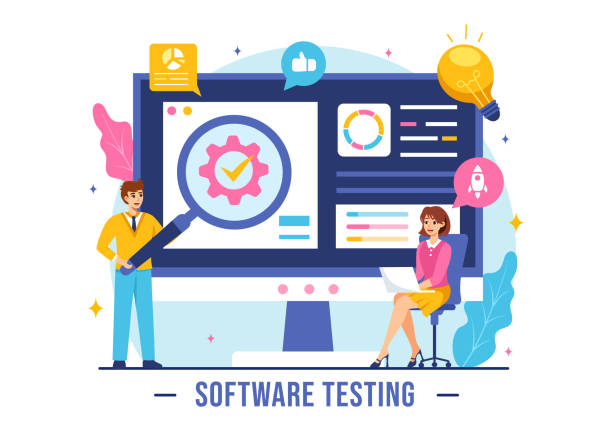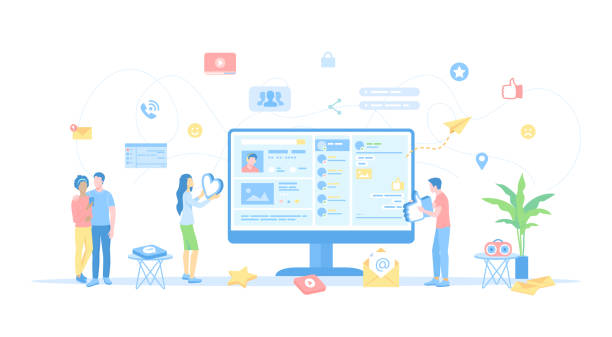Introduction to the Importance of Secure Website Design in the Digital Age

In today’s world, where all businesses and communications have shifted towards the online space, the concept of secure website design has gained increasing importance.
Websites are not only showcases for businesses but also a place for storing and processing sensitive user and company information.
An insecure website can lead to data breaches, cyberattacks, reputational damage, and even irreparable financial losses.
For this reason, security must be considered from the initial stages of website planning and design, and not merely as an add-on after completion.
In fact, web security is a continuous process that requires constant attention and regular updates.
This topic includes various aspects such as secure coding, proper server configuration, database protection, and user education.
The main goal of secure website design is to create a reliable online environment resistant to cyber threats, ensuring both user data protection and uninterrupted business operations.
In this article, we comprehensively and professionally examine various dimensions of this vital topic and provide practical guidelines for securing websites.
This explanatory content will help you gain a better understanding of web security challenges and their solutions.
Are you tired of your company’s website not being seen as it deserves, and losing potential customers? Solve this problem forever with professional and effective website design by Rasawp!
✅ Increase brand credibility and gain customer trust
✅ Attract targeted sales leads
⚡ Contact us now for a free consultation!
Familiarity with Common Web Security Threats and Their Impacts

To engage in secure website design, we must first become familiar with the types of common cyber threats that target websites.
These threats can occur through various methods such as SQL injection attacks, cross-site scripting (XSS), cross-site request forgery (CSRF), denial-of-service (DoS/DDoS) attacks, and many others.
Each of these attacks can lead to irreparable consequences, including theft of sensitive user information, manipulation of website content, service unavailability, and loss of business reputation.
For example, an SQL injection attack allows an attacker to access the database by inserting malicious code into website input fields, and read, modify, or even delete information.
An XSS attack also allows the attacker to inject malicious code into web pages, which is then executed by visiting users’ browsers and can lead to the theft of cookies or session information.
Recognizing these threats and understanding their mechanisms is the first step towards secure website design and establishing effective defenses.
This section provides an educational explanation of the details of these attacks to give you a comprehensive overview of the threat landscape.
A comprehensive security approach must include mechanisms for preventing, detecting, and responding to these attacks to ensure the website is resilient against a wide range of threats.
Best Practices for Secure Coding and Vulnerability Prevention

One of the most important pillars of secure website design is adhering to secure coding principles.
Developers must develop their code with security considerations from the very beginning.
This includes rigorous validation of user inputs to prevent attacks like SQL Injection and XSS.
User input data should never be trusted; all inputs must be sanitized and validated.
Using secure functions and libraries, keeping frameworks and development tools updated, and preventing the disclosure of sensitive information in client-side code or error messages are among these measures.
Also, proper error and exception handling, in a way that security information is not disclosed to the attacker, is crucial.
Using strong encryption principles to protect sensitive information and using hash functions to store passwords instead of plain text are other key aspects of secure coding.
Below is a table of the most common vulnerabilities and methods to prevent them, which can serve as a useful guide for developers.
This table specifically addresses approaches to counter each threat and provides practical guidance.
This section specializes in and guides secure coding topics, highlighting the importance of #input_validation and #proper_error_handling.
| Vulnerability | Description | Prevention Methods |
|---|---|---|
| SQL Injection | Unauthorized access to the database by injecting SQL code into inputs | Using Prepared Statements, Input Validation, using ORM |
| XSS (Cross-Site Scripting) | Injecting malicious scripts into web pages that are executed by the user’s browser | Sanitizing and Escaping all outputs, using CSP (Content Security Policy) |
| CSRF (Cross-Site Request Forgery) | Tricking users into performing unintended actions by exploiting authentication sessions | Using CSRF tokens, checking Origin and Referer, restricting GET requests for state-changing operations |
| Broken Authentication | Flaws in authentication and session management mechanisms | Proper implementation of login mechanisms, using Two-Factor Authentication (2FA), secure session management |
| Insecure Deserialization | Ability to exploit the deserialization process for remote code execution | Avoid deserializing untrusted data, monitoring deserialization traffic |
The Role of SSL/TLS in Securing Web Communications

One of the most fundamental yet crucial steps in secure website design is implementing an SSL/TLS certificate.
SSL (Secure Sockets Layer) and its newer, more secure version, TLS (Transport Layer Security), are protocols that encrypt communication between the user’s browser and the web server.
This encryption prevents eavesdropping, tampering, and forgery of information during transmission.
When a website uses HTTPS (HTTP Secure) instead of HTTP, it means its communication is secured by SSL/TLS.
This not only ensures the security of exchanged data such as credit card information, passwords, and personal details, but also gains user trust.
Browsers flag websites that do not use HTTPS as “insecure” which can negatively impact the site’s credibility and conversion rate.
Furthermore, search engines like Google prefer HTTPS-enabled websites in their search rankings, which is an SEO advantage in itself.
Choosing an appropriate SSL certificate (Domain Validated, Organization Validated, Extended Validation) based on the website’s needs and data sensitivity is part of the decision-making process for building a secure site.
Proper server configuration for optimal use of TLS protocols and disabling older, insecure SSL versions is also crucial.
This section descriptively addresses the importance of #communication_encryption and #SSL_certificates.
Losing potential customers due to an unprofessional website? Rasawp is your answer! With our specialized corporate website design services:
✅ Enhance your business’s credibility and standing
✅ Experience attracting more targeted customers
⚡ Act now for a free consultation!
Database Security: Protecting Vital Information

The database is the heart of every website, storing sensitive and vital information.
Therefore, database security is a fundamental component of secure website design.
Attacks like SQL Injection, mentioned earlier, directly target the database.
Several measures must be taken to protect the database.
Firstly, using the Principle of Least Privilege means that users and applications only require the minimum access necessary to perform their tasks.
Secondly, encrypting sensitive information in the database, especially personal and financial data, is essential.
Even if an attacker successfully gains access to the database, the encrypted information will be useless to them.
Thirdly, regularly updating the Database Management System (DBMS) and applying security patches to fix known vulnerabilities is highly important.
Fourthly, regular and secure backups of the database are crucial for data recovery in case of an attack or disaster.
Fifth, implementing Web Application Firewalls (WAF) can block many common database attacks before they reach it.
Also, monitoring database activities to identify suspicious and unusual patterns that might indicate an intrusion attempt is a key aspect of database security.
These comprehensive measures ensure that your website’s valuable data is protected against threats, making a significant step towards website security.
User Authentication and Authorization Mechanisms

The security of authentication and authorization are the main pillars in user access control and a significant part of secure website design.
Authentication is the process of verifying a user’s identity (e.g., with a username and password), while authorization determines what an authenticated user can do and what resources they can access.
For secure authentication, using strong passwords, hashing passwords with secure functions (like bcrypt or Argon2), and enforcing periodic password changes are essential.
Implementing two-factor authentication (2FA) or multi-factor authentication (MFA) is strongly recommended; this method creates an additional layer of security that makes unauthorized access difficult even if a password is compromised.
For authorization, using access control models like Role-Based Access Control (RBAC), where permissions are defined based on user roles, can simplify management and increase security.
Authorization logic should never be implemented client-side (frontend); all access checks must be performed server-side (backend).
Session Management is also highly important; session tokens must be secure, unique, and have an expiration time.
Overall, careful design of these mechanisms ensures that only authorized users can access relevant resources.
This educational and guidance content elaborates on the details of #authentication and #authorization.
Security Audit: Penetration Testing and Incident Response

The process of secure website design doesn’t end here.
A secure website requires continuous monitoring and evaluation.
Regular security audits, Penetration Testing, and vulnerability scanning are vital tools for identifying weaknesses before attackers discover them.
Penetration testing means simulating controlled cyberattacks to find vulnerabilities and assess system resilience.
This is performed by internal security teams or external specialists (ethical hackers).
The results of these tests must be carefully analyzed and used to address vulnerabilities.
Furthermore, having an Incident Response Plan for when a security breach occurs is essential.
This plan should include steps for identification, containment, eradication, recovery, and post-incident analysis.
The security team must be regularly trained and practice incident response protocols.
Security Information and Event Management (SIEM) systems can also help in quickly identifying threats by collecting and analyzing security logs and events.
This proactive and reactive approach makes the website resilient against new and evolving threats.
Below is a table of security tools and their applications.
This analytical and informative section emphasizes the importance of #penetration_testing and #incident_response in website security.
| Tool/Technique Name | Primary Use | Type |
|---|---|---|
| WAF (Web Application Firewall) | Filtering and monitoring HTTP traffic between the web application and the internet | Preventative |
| Penetration Testing Tools (e.g., Burp Suite, OWASP ZAP) | Identifying vulnerabilities through attack simulation | Diagnostic |
| Vulnerability Scanners (e.g., Nessus, OpenVAS) | Automated scanning of systems and applications to identify weaknesses | Diagnostic |
| SIEM (Security Information and Event Management) | Collecting, analyzing, and correlating security logs to identify threats | Monitoring & Response |
| Antivirus and Antimalware | Protecting the server against malware and viruses | Preventative |
| Intrusion Detection and Prevention Systems (IDS/IPS) | Monitoring network traffic for suspicious activities and blocking attacks | Preventative/Diagnostic |
Choosing Secure Hosting and Server Configuration

Secure website design is not limited to coding and databases; choosing a reputable hosting provider and proper server configuration also play a vital role.
An insecure server can nullify all your efforts to secure the code.
When choosing hosting, pay attention to factors such as advanced firewalls, intrusion detection systems, regular backups, and strong technical support.
Reputable providers usually offer comprehensive security solutions.
After choosing hosting, your server configuration must be done carefully.
This includes regular updates of the operating system and all server software (such as web server, database, PHP, etc.) to apply security patches, disabling unnecessary services to reduce the attack surface, and restricting access to files and directories.
Using server firewalls, implementing SSH Key Authentication instead of passwords for server access, and continuous monitoring of server logs to identify suspicious activities are other important measures.
Furthermore, separating development, testing, and production environments from each other to prevent potential intrusions during early development stages is strongly recommended.
A secure server configuration provides a solid foundation for a secure website and prevents common infrastructure-side attacks.
This section guides on selecting #secure_hosting and #server_configuration.
Did you know that 94% of a company’s first impression relates to its website design?
Rasawp, by providing professional corporate website design services, helps you create the best first impression.
✅ Create a professional and trustworthy image of your brand
✅ Easier attraction of potential customers and improvement of online standing
⚡ Get free corporate website design consultation
The Human Element: Training and Awareness in Web Security

Despite all technological advancements in the field of secure website design, humans remain the most vulnerable link in the security chain.
Many successful cyberattacks occur through social engineering and tricking users or employees.
Therefore, educating and raising awareness among employees and even website users about security threats and best practices for protecting themselves and their information is of paramount importance.
These trainings should cover topics such as recognizing phishing emails, the importance of using strong and unique passwords, the dangers of clicking on suspicious links, and how to identify fake websites.
For developers, continuous training on secure coding principles and the latest vulnerabilities is essential.
For web administrators, awareness of how to manage access, monitor logs, and respond to incidents is crucial.
Establishing a security culture within the organization and encouraging employees to report any suspicious activity can significantly increase the overall level of security.
An informed and vigilant human workforce can neutralize many cyberattacks in their early stages and prevent a small incident from escalating into a major crisis.
This is a critical aspect often overlooked, but essential for comprehensive website security, and it creates thought-provoking and engaging content regarding awareness.
The Future of Secure Website Design and Continuous Improvement

The world of cybersecurity is constantly changing and evolving; attackers are always looking for new methods of intrusion, and security professionals are always striving to develop new defenses.
Therefore, secure website design is not a static process, but requires continuous improvement and updating.
The future of web security will likely see the emergence of technologies like Artificial Intelligence and Machine Learning for detecting and preventing more sophisticated attacks, as well as the widespread adoption of security architectures like Zero Trust.
Websites should be regularly scanned for new vulnerabilities, all software used (from operating systems to website plugins) must always be up-to-date, and incident response plans should be periodically reviewed and practiced.
Collaborating with the security community, studying the latest vulnerability reports, and participating in specialized training courses can help developers and web administrators stay one step ahead of threats.
Adopting DevOps and DevSecOps approaches, which integrate security from the very beginning of the software development lifecycle, are also important future trends.
Ultimately, focusing on a strong security culture and investing in appropriate tools will ensure that your website remains resilient against future security challenges.
This analytical section refers to #future_security_trends and #continuous_improvement.
Frequently Asked Questions
| Question | Answer |
|---|---|
| What is secure website design? | Secure website design is a process in which websites are built with security principles in mind to be resilient against cyberattacks and to protect user and business information. |
| Why is secure website design of high importance? | To prevent unauthorized data access, sensitive information leaks, malware attacks, loss of user trust, damage to business reputation, and legal consequences resulting from data breaches. |
| What are the most common website vulnerabilities? | SQL Injection, Cross-Site Scripting (XSS), Cross-Site Request Forgery (CSRF), Broken Authentication and Session Management, and Sensitive Data Exposure. |
| How can SQL injection attacks be prevented? | Using Prepared Statements with Parameterized Queries, Input Validation, and restricting database access. |
| What are the methods to counter XSS (Cross-Site Scripting) attacks? | User Input Validation, Output Encoding before displaying in HTML, and using Content Security Policy (CSP). |
| What is the role of HTTPS in website security? | HTTPS encrypts the communication between the user’s browser and the website server using an SSL/TLS certificate, preventing eavesdropping, tampering, or forgery of data. |
| What are the best methods for user password management? | Enforcing the use of strong passwords (a combination of letters, numbers, and symbols), hashing passwords instead of storing them directly (with strong algorithms like bcrypt), and enabling two-factor authentication (2FA). |
| What is the importance of User Input Validation? | Input validation prevents the entry of malicious or unexpected data into the system, which can lead to vulnerabilities like SQL Injection or XSS. |
| What impact do security reviews and regular audits have on site security? | These reviews help in early identification of vulnerabilities and security weaknesses, enabling their remediation before they can be exploited. |
| What is the application of Web Application Firewall (WAF) in secure website design? | A WAF acts as a protective layer between the user and the website, analyzing incoming traffic, identifying, and blocking common web attacks such as SQL Injection and XSS. |
And other advertising agency services by Rasaweb in the field of advertising
Smart Marketing Automation: A blend of creativity and technology for digital branding through intelligent data analysis.
Smart Customer Journey Mapping: Professional optimization to increase click-through rates using Google Ads management.
Smart Website Development: Revolutionize sales growth with user experience customization.
Smart Advertising Campaign: An effective tool for customer acquisition with the help of SEO-driven content strategy.
Smart Customer Journey Mapping: Revolutionize campaign management with intelligent data analysis.
And over hundreds of other services in internet advertising, advertising consultation, and organizational solutions
Internet Advertising | Advertising Strategy | Advertorials
Resources
Website Security and Advanced Solutions
Secure Website Design: Key Tips
Secure Web Development Guide for Managers
Advanced Web Security Principles
? Are you ready to transform your business in the digital world? Rasaweb Afarin Digital Marketing Agency, specializing in responsive website design, SEO, and online campaign management, is your comprehensive solution for growth and visibility. For consultation and to take big steps towards success, contact us today.
📍 Tehran, Mirdamad Street, next to Central Bank, Kazeroun South Alley, Ramin Alley, No. 6




